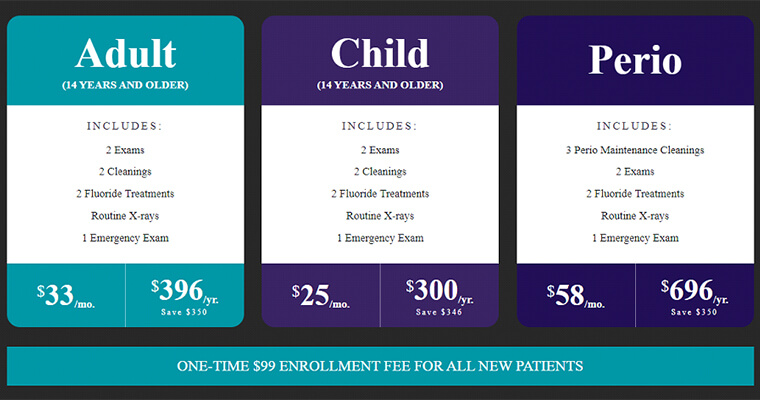Think You Know Dental Membership Plans? Think Again!

Dental membership plans are not a new concept; modern practices know that the business value of a participating member patient far exceeds an uninsured one.
Here’s why: Member patients pay your practice directly and on time. Since the membership plan is a subscription for a bundle of preventive services at a discount, members visit regularly for hygiene visits and accept X-rays when requested. Consequently, treatments presented (and accepted) increase. Members become your most loyal and lucrative patients.
While your practice(s) benefits from subscription dentistry, so do your patients.
There is plenty of research that shows uninsured patients don’t visit the dentist regularly. The top reason is that they fear the uncertainty of related costs. Even with dental insurance, I experience this stress whenever I visit the dentist. A membership plan with clear terms and pricing alleviates this stress and enables the patient to embrace a biannual visit to the dentist per the standard of care. Consequently, your member patients are empowered to care for their oral health. Membership plans enable this change in patient behavior.
Using anecdotal evidence from our participating practices, here are the numbers:
Production from a member patient is three times that of an uninsured patient ($515 versus $172). This increase comes from two sources: 1.) Member patients who previously visited every 18 months now pay your practice a steady revenue stream to visit biannually, and 2.) member patients accept 50-75% more treatment than uninsured patients. The numbers look good, and the recurring, high-margin revenue can transform your practice.
The Value of Membership Management Software
With this obvious value, practices have easily embraced membership plans. The software platforms that manage these plans support your team as they custom design and roll out membership options specific to your patients. These platforms also handle all the communication with your patients, including renewals and notifications. And they provide reporting and analysis of the business impact of your program. Software that’s integrated into your practice management software can help your office make a business decision to drop the worst performing PPOs and instead, offer a membership plan.
Here’s a bold but true statement: A practice or group serious about membership plans cannot scale their plans without software. The software automates patient communications and manages the renewals automatically. Without the right software, patients may not renew until they come into the practice again, leading to months of lost membership revenue to the practice. And the software providers will support your team in selling the plans with collateral, scripts, postcards, texting outreach, and more.
When you start to evaluate the different software platforms available, it can become confusing. You will find companies offering software to support membership plans, discount plans, and savings plans… what’s the difference? They all sound the same.
Some companies offer platforms to the practice for the office manager to sell to the patient. Others are two-sided marketplaces matching uninsured patients with discounted fees offered by providers through their platform.
The differences between all these plans are nuanced, but the business value is not; a member patient is the most valuable not only because they can multiply a practice’s production threefold but also because member patients renew 80-90% of the time. The laws of economics apply here; as we know, it’s far cheaper to retain an existing patient than acquire a new one.
Membership vs. Savings or Discount Programs
Outside of memberships, no other plans change patient behavior and retain patients for the practice. In fact, we’ve found that patients who have purchased discount or savings plans renew approximately 50% of the time. This is only slightly better than the industry average of 41%, according to Jarvis Analytics. Think about this for a moment: If you sign 50 new discount/savings plan patients in May, only 25 will renew a year later. In contrast, sign 50 new member patients in May, and 43 will renew a year later.
Here’s why:
To enroll in a discount/savings plan, the patient pays an enrollment fee. Only when they have paid the fee can they access the savings you offer, a la carte. Next year, to rejoin the plan, they must pay a new enrollment fee. Many choose not to renew. A gym or a tennis club may ask for an enrollment fee once, but how many would stay if they were asked to enroll each year?
Here are some other things to consider with a discount/savings plan: Since services are discounted and offered a la carte, these patients still experience the cost stress I described earlier. Even though X-rays, fluoride (and all preventive services) are discounted, these patients may still decline them. And the patient has no incentive or reason to visit biannually; they are still paying for each and every preventive service, albeit at a discounted price.
The net result is that hygiene recall is not optimized; in fact, many practices offering a discount/savings plan will use their hygiene department as a loss leader. An even bigger opportunity cost is that practices offering a discount/savings plan will forego the increased treatment acceptance that comes with member patients accepting regular X-rays. In sum, patients buying a discount/savings plan tend to be price (not quality) shoppers, and these plans do not change patient behavior in their oral care journey.

Sample membership plans.
Using software to manage your practice(s)’ membership plans is the best way to go. A partnership through Plan Forward’s software package includes benefits such as:
- Giving the provider/practice location 100% control of their plan. The provider sets their own plan fees, and they have their own merchant account where they collect the gross fees. At the end of the month, we will charge the practice(s)’ credit card for our fees. Collecting gross fees makes production reconciliation a piece of cake.
- Our HIPAA-compliant agreements define a direct relationship between the provider and the patient to drive loyalty and patient retention. Each practice location has the power to define its own fee schedule/plan types/payment frequency (monthly/annual), etc., to cater to its specific patient demographic. Also, the Plan Forward platform is white-labeled to drive loyalty to the practice.
- Membership plans bundle preventive care (2 exams, 2 cleanings, X-rays, fluoride, and an emergency visit are typical) for one price. As a result, hygiene stops being a loss leader, and treatment acceptance grows 50-75% higher (because member patients take X-rays as they’ve already paid for them). The practice retains the patient 80-90% of the time. Membership plans drive recurring, high-margin revenue and can double production from uninsured patients who become members.
- Our special value-add is how we help the practice(s) grow their plan.
The world is changing; we’ve learned to buy countless services with a subscription, including access to movies, news, groceries, and clothing. Why not dentistry?
Now that we’ve laid out the value-add from implementing a membership plan, if you’d like to learn more about how we can help you create lasting business impact in your practice(s), come find us at www.planforward.io…Click to learn more in a new window….
About the Author

Jane started her career on Wall Street in equity research and continued investing at Flatiron Partners, working on Series A stage startups. Jane ran a hedge fund and her own family office until she saw the light in 2017 and joined Henry Schein’s Innovation Center.
She joined Jarvis Analytics in May 2020 (sold to Henry Schein) and Plan Forward, as co-CEO, in October 2021.
Jane also serves on the Board of CareCru.
www.planforward.io…Click to learn more in a new window…






